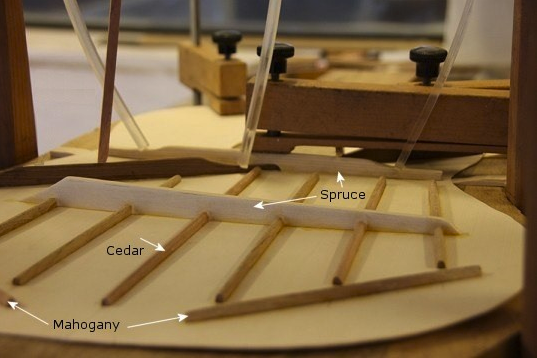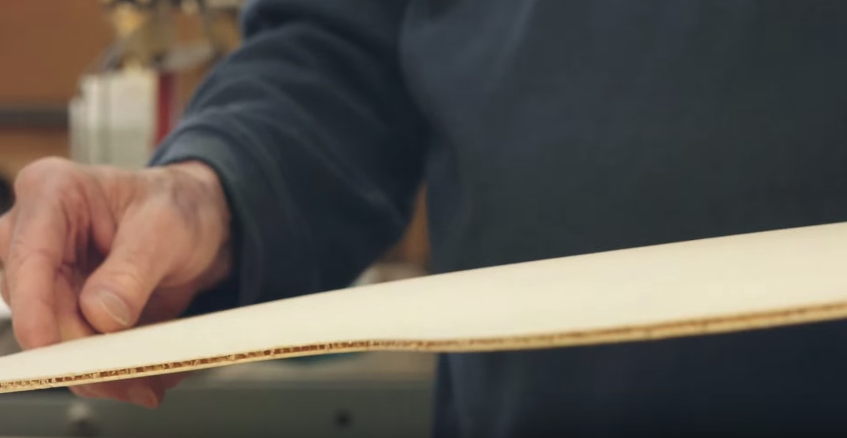Introduction
Of all the classical guitar design innovations that have evolved over the past three decades soundboard design is the one that has probably had the most time, effort, and thought dedicated to its development.
Why is this? The soundboard is where it all happens. It’s the engine room and apart from your fingers the soundboard is the single-biggest factor in determining and shaping the overall sound and characteristics of the sound that you produce.
Traditional Soundboard Design
Traditional soundboard design is based around the Torres fan bracing style (see my other article on classical guitar bracing here) combined with a single piece of wood. That’s the short of it. Have a look at the image below to see what a traditional soundboard looks like.
Double Top; Composite Top; Sandwich Top
As you can see in the image above a ‘Double Top’ or ‘Sandwich Top/Composite Top’ as it also called has two extremely thin pieces of wood joined together by a central core. Matthias Dammann is the German luthier associated with creating the first double tops for classical guitars however, it is Gernot Wagner (also from Germany) that suggested to Dammann to replace the tiny filaments of wood that he was using as the core with another material known as nomex.
Luthiers will usually apply a thin layer of epoxy to the nomex and the add the wooden top and bottom afterward effectively ‘sandwiching’ the nomex in-between using a vacuum press to seal all the bits together. The result is an exceptionally stiff & strong yet light and durable soundboard with delightful sonic capabilities often described by guitarists as having increased volume, a wider dynamic range, and lower bass fundamentals.
Famous Classical Guitar Luthiers Building Double Tops
- Matthias Dammann (watch a video of me playing a 1995 Dammann in Hong Kong)
- Gernot Wagner
- Jim Redgate
- Robert Ruck
- Greg Smallman (read my article on lattice bracing)
Famous Players Playing Double Tops
- Jason Vieaux
- Manuel Barrueco
- John Williams
- David Russell
- Scott Tennant
How You Can Get Your Hands On A Cheap One!
As you’ve probably guessed guitars from those luthiers don’t come cheap so start saving or alternatively can source some nifty double tops from Aiersi in China starting at around US$500. I came across them out of curiosity when I was living in China. Considering what you’re paying you get quite a decent guitar that usually has all the bells and whistles including:
- 7 strings (if you want that)
- Double top (obviously)
- Armrest
- Elevated fretboard
- Soundport
- Electrics
- All solid wood
- 20th fret
I’m not endorsed by Aiersi but I do think they represent a good deal if you haven’t got US$10k lying around under the couch cushions. I should point out that Aiersi do offer OEM which basically means that if you buy X amount you can put your own label on them and start marketing them as your own brand. I’ve got nothing against that personally but you can expect (and I have seen these prices recently) to pay about US$2k if you live in the USA or a similar amount in Canadian $. I saw a fellow classical guitarist YouTuber recently post a review of a new brand in Canada selling Aiersi guitars as their own brand for 2k (they just put a fancy Italian/Spanish sounding name on it). Do yourself a favour – just buy direct from Aiersi but be sure to do your homework with your local import government office and be aware of any import duties, taxes, and also check that the wood the guitar is made from isn’t subject to any regulations.
Check out my other articles in the
‘Modern Classical Guitar Design Series’:
Part 8: Fanned Frets
Part 7: Arched back
Part 5: Lattice Bracing
Part 4: Armrest
Part 3: Soundport
Part 2: Indented Cutaway
Part 1: Elevated Fingerboard
Let your fingers fly!



